In Buddhism, there is a worldview which posits 6 realms of existence through which human beings move during their cycles of reincarnation. In American Zen thought, these realms are not considered to be real places, but allegories of how we keep ourselves in “dukka”, or suffering. I remember a wonderful talk by
AZC senior lay-practioner Pat Yingst on these realms of existence where she suggested that in any given day we could move through all 6 realms as we found various ways to divide ourselves from the present moment – to keep ourselves alienated from the world around us.
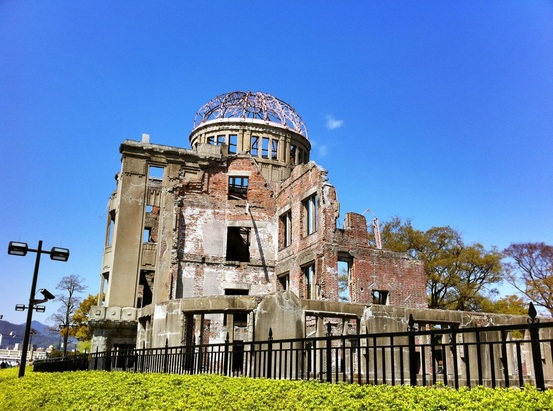
The "A-Bomb Dome", formerly the Hiroshima Prefectural Commercial Exhibition Hall was one of the few buildings close to the blast radius to survive
As we visited Peace Park in Hiroshima, the site of the dropping of the first atomic bomb on August 6th, 1945, I felt like I was moving through all 6 hell realms as I tried to understand the the reasons for it being dropped and the devastation that ensued. At first I felt it was entirely unnecessary to drop the bomb and at other times I wasn't so sure. The fact is, it was a messy situation with many different factors involved. In order to capture this experience, we will look at each realm and how it may connect within a historical context to the first half of 1945, when Japan was losing the war but unable to come to a peace agreement with the allies.
1. The Realm of Devas (Gods) and Heavenly Beings
The Deva realm is populated by godlike beings who enjoy great power, wealth and long life. They live in splendor and happiness. Yet even the Deva grow old and die. Further, their privilege and exalted status blind them to the suffering of others, so in spite of their long lives they have neither wisdom nor compassion.”
The fanaticism of powerful aspects of the Japanese military government seemed to be residing in this realm, where they were completely disconnected from the suffering of their people. Even as Japan’s navy lay destroyed and surrender seemed inevitable, the Big Six or Supreme War Council in Japan, declared a formal policy of the
"honorable death of the hundred million" - national suicide.
2. Asura-gati, the Realm of Asura (Titans)
The
asura realm is populated by powerful beings who experience a life that could be almost as pleasurable as that of the devas in the heaven realm. However, the asuras are very envious and suspicious of each other and the devas, so they spend their time absorbed in great wars and conflicts instead of enjoying themselves. The realm is full of assembling armies and asuras in battle gear. Even though they value justice, wisdom and faith, they always desire to be superior to others, so they are competitive and egotistical.
Sounds a bit like the cold war, huh? The Hiroshima Peace Memorial Museum outlines how during the February 1945 Yalta Conference including Roosevelt from the US, Churchill from the UK, and Stalin from the USSR, the USSR agreed to enter the war against Japan three months after a German surrender. The US and UK made concessions to achieve this agreement, like granting the USSR railways in Manchuria and Port Arthur. But once the atomic bomb was successfully tested in the Trinity test of July 16th, the US began to fear that the Soviet Union entering the war and providing the decisive step in the surrender of Japan might lead to their expansion of influence throughout the Pacific. They wanted to limit Soviet control and a belief was that dropping the bomb might cause Japanese surrender prior to the Soviet Union entering the war. So with their mistrustful power struggle as a motive, over 100,000 people died unthinkable deaths as the heat, radiation, and shockwaves poured over an entire city.
3. The Human Realm
The
Human Realm is the only realm of the six from which beings may escape samsara. Enlightenment is at hand in the Human Realm, yet only a few open their eyes and see it. Rebirth into the Human Realm is conditioned by passion, doubt and desire.
It’s ironic that the military commanders of Japan claimed they would not surrender unless the Emperor system was retained in Japan. Some argue that by the Emperor system, they simply meant the old militaristic order in Japan, which they controlled. The Japanese Ambassador to Russia, Naotoke Sato, wrote to the Big Six prior to the bombing that an unconditional surrender with the sole proviso of the preservation of the Emperor would probably even be accepted, but the Japanese leadership refused to consider it. Why? The military were all to human in holding onto their positions of power at the cost of their own people, even when given the choice to have the Emperor remain in some position of authority (which he did after the war).

Paper cranes at the Children's Peace Monument honor Sadako Sasaki, who was exposed to the bomb at the age of 2 and seemed healthy until developing Leukemia 10 years later. She attempted to fold a 1000 cranes in the hope it would help her recover. per old Japanese folklore. Sadly, she only reached 644 before dying on October 25, 1955. Her friends and family finished the cranes for her and now children all over Japan fold in her memory.
4. The Animal Realm
Animal beings are marked by stupidity, prejudice and complacency. They live sheltered lives, avoiding discomfort or anything unfamiliar. Rebirth in the Animal Realm is conditioned by ignorance. People who are ignorant and content to remain so are likely headed for the Animal Realm, assuming they aren't there already.
Even after both bombs had been dropped and the Soviet Union entered the war against Japan, the Army (led by minister Anami, who committed suicide after the war) was unwilling to surrender, wanting to make terms that were more favorable to Japan. There was even a coup, called the Kyūjō Incident, where hardline factions within the military attempted to assassinate key parties to prevent surrender. With this sort of fanaticism, even in the face of clear defeat, was there any choice about whether to drop the bomb? The Army held a crucial seat on the Big Six and could effectively block any entreaties for peace, which they did even after both bombs were dropped. Only the Emperors intervention ordering them to make peace eventually forced Japan to surrender.
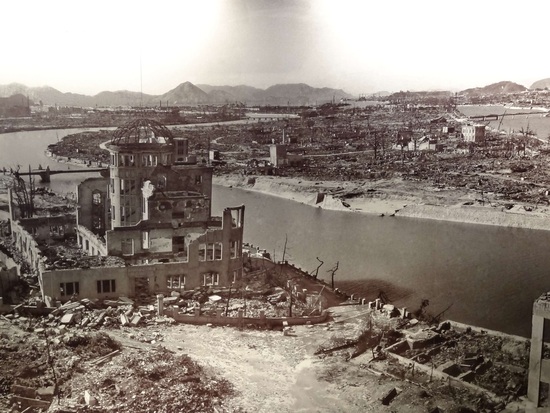
Epicenter of blast area - Hiroshima. The A-bomb dome sits shattered in the foreground.
5. The Realm of Hungry Ghosts
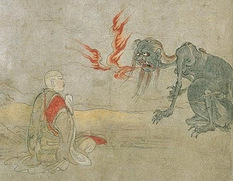
Hungry ghosts (preta) are pictured as beings with huge, empty stomachs, but they have pinhole mouths, and their necks are so thin they cannot swallow. A hungry ghost is one who is always looking outside himself for the new thing that will satisfy the craving within. Hungry ghosts are characterized by insatiable hunger and craving. They are also associated with addiction, obsession and compulsion.
The Manhattan Project was achieved at a cost of over 2 billion dollars and the work of over 120,000 people. It was a massive expenditure of resources and those behind it, like Director of War Mobilization James Brynes, worried that if the bomb wasn’t used and proved effective, criticism and investigation would follow. The Secretary of War, Stimson, supposedly said to President Truman that he worried that the already bombed out Japanese cityscapes would prevent the US military from measuring the true effectiveness of the weapon. Thus, potential target cities were not subject to air-raids in the months before the bombing.
6. The Hell Realm
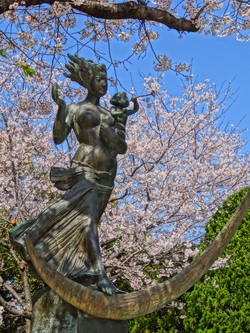
As the name suggests, the Hell Realm is the most terrible of the Six Realms. Hell beings have a short fuse; everything makes them angry. And the only way hell beings deal with things that make them angry is through aggression -- attack, attack, attack! They drive away anyone who shows them love and kindness and seek out the company of other hell beings. Unchecked anger and aggression can cause rebirth in the Hell Realm.
Despite having no bargaining chips, the Japanese military developed the Ketsu-go strategy, which was to have such a fierce defense of the Kyushu beaches that Americans would take incredibly heavy casualties on their first assaults of the Japanese mainland.
They hoped the Americans would blanch at such losses and negotiate peace in a way that would grant the military continued power over Japanese society. Still, there is belief among
some historians that even without the use of the atomic bomb, which killed between 90,000–166,000 people in Hiroshima (of acute symptoms alone) Japan would have surrendered. This assumes a continuation of the conventional air raids that had already pulverized most of Japan’s cities. We have seen the results of this as we travel around the country to find most of the gardens and castles to be reproductions built since the war. Amazingly, by March of 1945 “conventional” warfare was nearly the equivalent of the atomic bomb in destructive capacity. Waves of small napalm like bombs were dropped onto the city’s civilian population and the fires spread and connected into a huge firestorm that sucked all the air out of the atmosphere. In one such raid in Tokyo, 125,000 people perished. The Allies bombed Hamburg and Dresden in the same manner, and Nagoya, Osaka, Kobe, before then bombing Tokyo a second time.
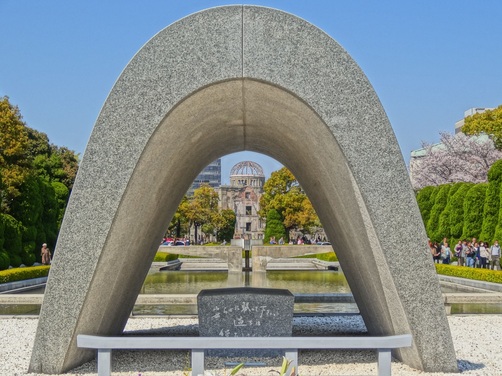
Flame of Peace & A-bomb Dome as seen through Hiroshima Peace Memorial
Well, we’ve moved through the six realms of human existence and examined the different aspects of the decision to drop the bomb on Hiroshima. For me it was an incredibly emotional experience to read about the abstract decision making on the part of both sides but to then so viscerally see the effects of those decisions on the innocent civilians of Hiroshima. So often it is the least of us who suffer for the ignorance and delusion of the powerful.
We've shared many of the pictures of the Hiroshima Peace Park & Museum above, but to see all the pics of the area as well of Miyajima (mentioned below),
click here: 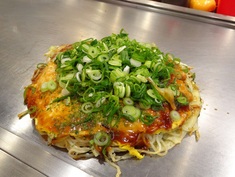
Feeling a bit somber after the museum and exploration of Peace Park (which you’ve seen in pictures above), we headed off to the famous institution of Okonomiyaki-Muri, where there are 3 floors of cooks all dishing up the Hiroshima version of the Japanese pizza/omelet. All the cooks entreated us as we looked at the different stalls, which featured Okonmiyaki made up of layers of ingredients instead of mixed together.
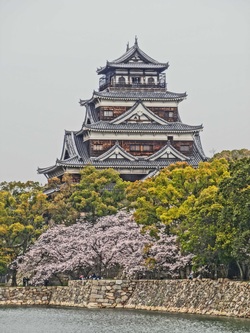
The next day we paid a visit to the rebuilt Hiroshima Castle, where we learned about the different construction styles of castles throughout Japan. This ranges from mountaintop castles built for defense in the early days of the Shogun to later peace-time castles built on flatlands that served mainly administrative functions. Then we took the ferry over to the famous Miyajima Island, right off the coast of Hiroshima in the Seto Inland Sea. The island is famous for the Itsukushima Shrine, a Shinto shrine with a beautiful Torii gate that appears to float in the water at high tide. We also enjoyed the Shingon Buddhist Temple of Daishoin,
which features a cave symbolizing the entire 88 temple pilgrimage route of Shikoku and humorous Buddhist related statuary like the
five hundred Rakan (many of which sported adorable quilted hats). The colorful temple also sported a long nosed
Tengu (mountain spirit and defender of the dharma) and fierce looking Myo-o Buddhas who are committed to “encouraging” humans to follow Buddhism. Glad I didn’t meet one of them when I first started meditating!
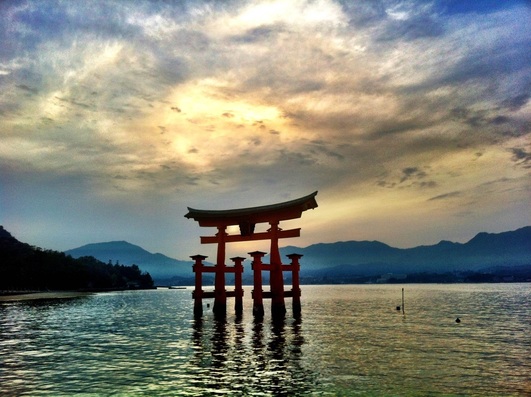
Itsukushima Shrine off Miyajima Island
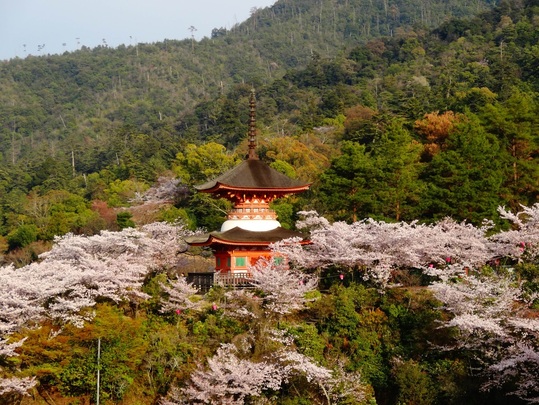
Tahoto Pagoda in Miyajima with an honor guard of cherry blossoms
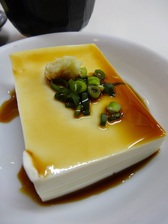
Mmm...tofu
From Hiroshima we took another trip on the Shikansen to arrive in Okayama, famed for its
Korakuen Garden. Hungry for lunch, our first stop was at Okabe Restaurant, which specializes in home-made tofu. Oishi! (Japanese for delicious). Then onto the park, which was full of cherry blossoms in full bloom. One of the most interesting features of the garden is its use of "
borrowed scenery", incorporating the nearby Okayama Castle into the various views you experience as you stroll along its paths. But the highlight may have been after the garden, as we walked along the Asahigawa Sakuramichi Walk, lined with over 250 Someiyoshino cherry trees in full bloom. The trees were lined with revelers having
hanami parties (cherry blossom viewing parties) so we figured, “when in Rome!”. We bought ourselves some snacks and beers and sat down under the trees to
enjoy them Japanese style!
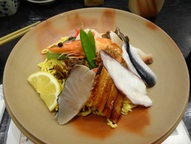
The next day brought rain and a day to relax (and for me to write this blog). We also had an excellent lunch sampling the local specialty of barazushi and a wonderful dinner with duck cooked on a charcoal grill and cold soba salad. Perhaps most charming in this small town was how the servers at both places we ate dinner walked outside to say goodbye to us, making us feel like family.
Despite the sordid history discussed in this post, traveling through Japan today certainly seems more like traveling through the Deva realm rather than the hell realm it had become by the end of World War II. But maybe by remembering how easily we can move from one realm to the other, in our individual lives and in our national policy, can help avoid such wanton destruction in our future.
For all the pictures of Okayama & the Korakuen Garden
click here:







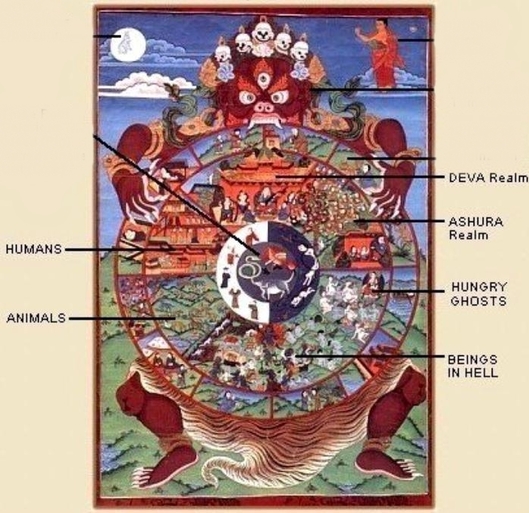

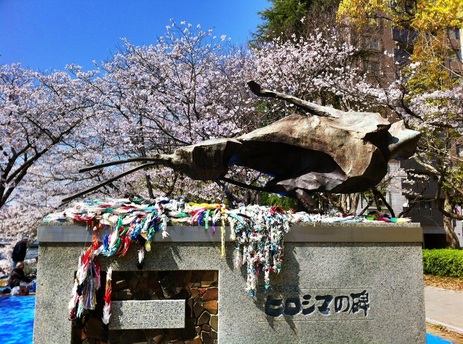
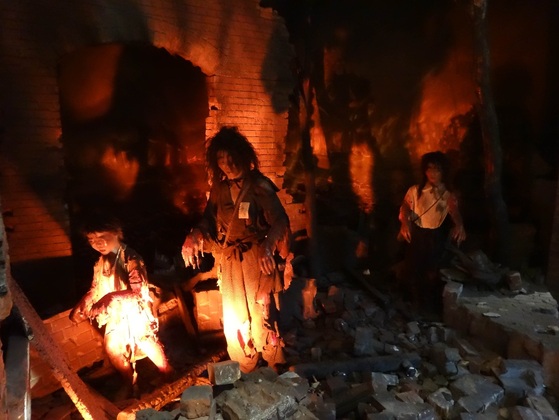

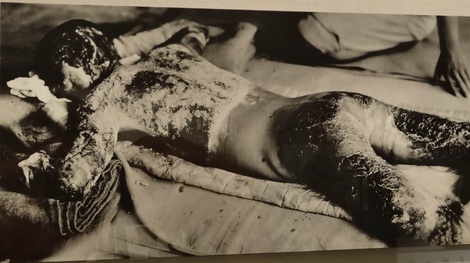



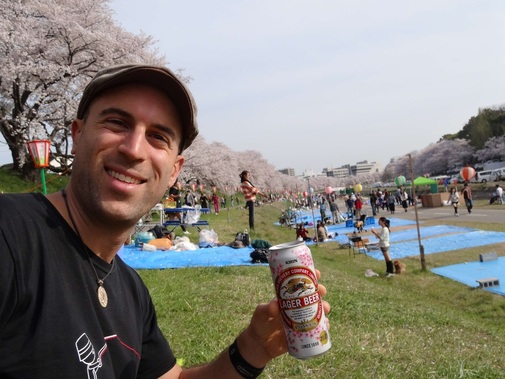
 RSS Feed
RSS Feed
